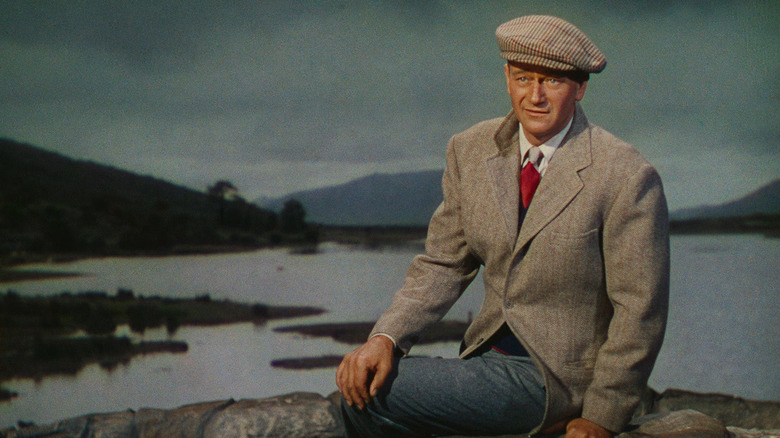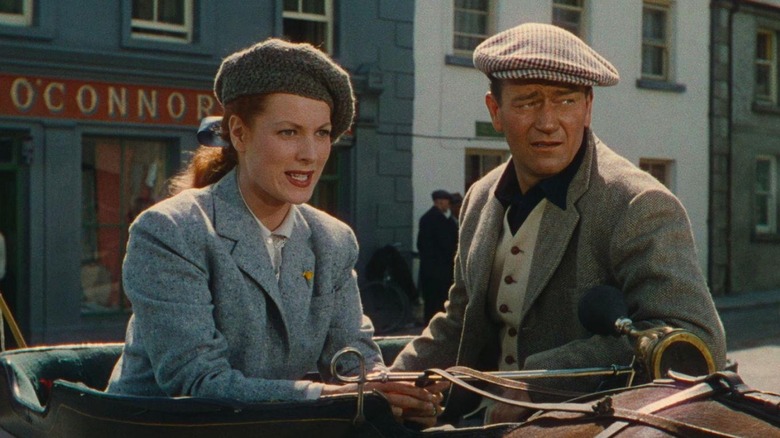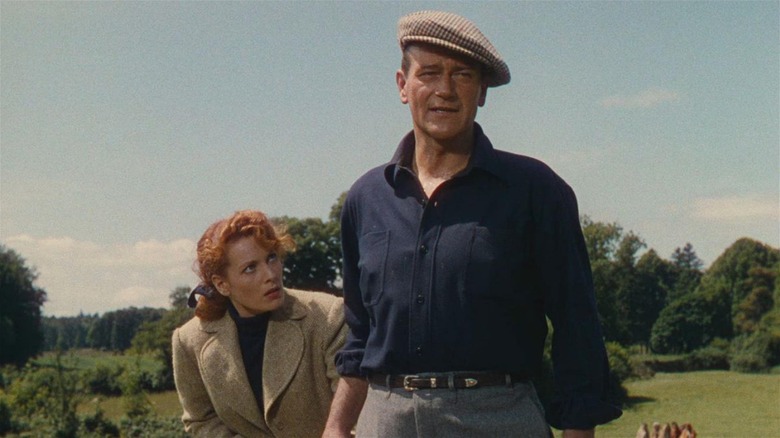John Wayne Felt This '50s Rom-Com Was One Of His Best Movies
Few Hollywood filmmakers are as closely associated with a particular genre as John Ford is with the Western, but it is perhaps less well-known that he received some of his greatest acclaim beyond his trademark horse operas. He still holds the proud record for the most Academy Awards for Best Director, having taken home the top prize for "The Informer," "The Grapes of Wrath," "How Green Was My Valley," and "The Quiet Man." The latter was arguably the farthest outside his usual wheelhouse, a Technicolor romantic comedy shot in his parents' homeland of Ireland. He took several of his regular actors (including Ward Bond and, of course, John Wayne) with him for company, however, and the Duke considered the resulting picture one of his best films.
Wayne praised "The Quiet Man" highly among his own extensive filmography. During his infamous interview with Playboy in 1971, he was asked whether he considered "True Grit" one of his best movies. He responded:
"No, I don't. Two classic Westerns were better — 'Stagecoach' and 'Red River' — and a third, 'The Searchers,' which I thought deserved more praise than it got, and 'The Quiet Man' was certainly one of the best. Also the one that all the college cinematography students run all the time — 'The Long Voyage Home.'"
"The Quiet Man" was a change of pace for Ford, who had decided he wanted to take a break from Westerns after he had finished shooting the lesser-known but highly rated "Wagon Master" with Bond, Ben Johnson, and Harry Carey Jr. He thereafter turned his attention to adapting "The Quiet Man," a short story set in rural Ireland by Maurice Walsh, whom the filmmaker had paid $10 for the rights many years earlier. The Irish novelist would receive a far more substantial fee once Republic Pictures green lit the project, but the studio was unconvinced about its commercial potential and insisted that Ford make "Rio Grande" first. Although the third of Ford's so-called Cavalry Trilogy was more familiar territory for the director, it was, in many ways, a dry run for "The Quiet Man" with its central romance pairing Wayne opposite Maureen O'Hara for the first time. The duo would star in five pictures together in total, but none would be as well-received as Ford's Irish-set rom-com. Let's take a closer look and see how it holds up today.
What happens in The Quiet Man?
Set in the 1920s, "The Quiet Man" stars John Wayne as Sean Thornton, an amiable Irish-American former boxer who returns from Pittsburgh to his birthplace, a picturesque (fictional) village on the west coast of Ireland called Inisfree. He plans to settle down in the community and buy the old family cottage, and he receives a warm welcome from most of the locals apart from Will Danaher (Victor McLaglen), a mean, middle-aged squire who also wants to purchase the property. The battle lines are drawn when the owner, Widow Tillane (Mildred Natwick), accepts Thornton's offer over Danaher's.
Tensions rise even further when Thornton falls in love with his rival's quick-tempered sister, Mary Kate (Maureen O'Hara). Thornton quickly proposes but their chances of marital bliss look slim when Danaher refuses to give his blessing out of sheer spite. This leads boozy coach driver Michaeleen Óge Flynn (Barry Fitzgerald) and kindly vicar Peter Lonergan (Ward Bond, because John Ford had to fit him in somewhere) to play matchmakers between Danaher and the widow, tricking him into believing she will only marry him once Mary Kate has left home.
All looks rosy until Danaher realizes he has been duped on Thornton and Mary Kate's wedding day. Angered once more, he refuses to give his sister her dowry. Thornton doesn't care about the money, but his failure to understand its importance to his new bride under Irish customs immediately drives a wedge between them. Mary Kate accuses him of cowardice when he declines to fight Danaher over the issue, having sworn off violence after a tragic incident in his past. But when Mary Kate threatens to leave, Thornton is reluctantly spurred into action.
It's easy to see why Wayne was proud of "The Quiet Man." Better known for his onscreen heroism and macho posturing in Westerns, the role of Sean Thornton gave the actor a chance to show more range than he was often given credit for. He and O'Hara also had good chemistry together, while the rest of the supporting cast give the film an easy-going charm, with McLaglen adding to his Oscar win for Ford's "The Informer" by scoring another nod for his hefty performance as Danaher. Wayne was a strapping guy, but the hulking veteran sure looks like someone who could match him blow-for-blow, as we see in the movie's celebrated climactic fist fight.
How does The Quiet Man hold up today?
Despite their reputation as deeply conservative figures, John Ford and John Wayne were capable of making some surprisingly progressive pictures together, including the difficult production that was "The Man Who Shot Liberty Valance" (a film that, with its nuanced insight into the democratic process, still feels incredibly relevant today). "The Quiet Man" isn't one of them, however, as it's rooted firmly in old-fashioned gender values and cultural stereotypes.
I watch a lot of older movies, and I think it's important to take a balanced approach when it comes to stuff that would be unacceptable in a film shot today. I'm also very much about trying to separate the art from the artist, which is why I'm able to enjoy Wayne's movies despite his offscreen legacy as a horrible bigot. Without a little leniency, you'd end up canceling about half of Hollywood's 20th Century output. But sometimes the problematic elements are just too much, like how Mary Kate is portrayed in "The Quiet Man." Maureen O'Hara makes her a feisty character who tries to stand her ground, but she is treated like property by Thornton and Danaher and turns into an obedient little woman later in the movie. Sure, the film is set in a rural community in the 1920s, and this may well be a fair representation of gender roles at the time. But what makes it troublesome is how implied sexual violence and domestic abuse are played for comic value, culminating in a lengthy scene where our hero drags his wife across country by the scruff of her neck in front of the cheering locals.
Then there is the way the villagers are mostly garrulous and hard-drinking stereotypes. You might think Ford would have avoided such cliches given his Irish heritage, but what it amounts to is a load of nostalgic Hollywood blarney. (Seriously, Barry Fitzgerald might as well be wearing a leprechaun outfit in this movie.) Which is a shame, because "The Quiet Man" is very well-acted and good-looking blarney. Wayne is convincing as a romantic leading man, apparently just as comfortable in tweed and a flat cap as he was in a Stetson and a cavalry uniform, and the lush Irish landscapes are absolutely ravishing thanks to the verdant Oscar-winning cinematography. Indeed, "The Quiet Man" may well be Ford's most beautiful movie — It's just a shame the content has dated so badly.


